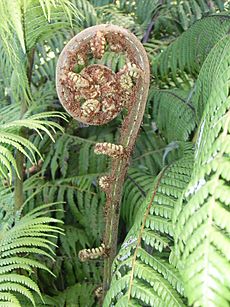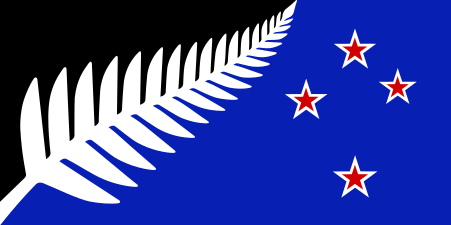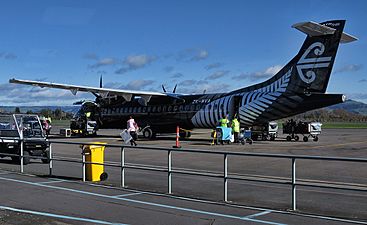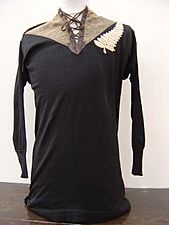Silver fern facts for kids
Quick facts for kids Silver fern |
|
|---|---|
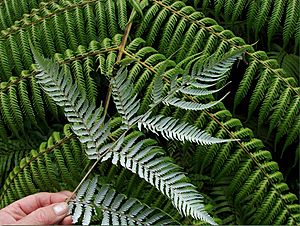 |
|
| Frond, showing silver underside | |
| Scientific classification | |
| Genus: |
Alsophila (plant)
|
| Species: |
dealbata
|
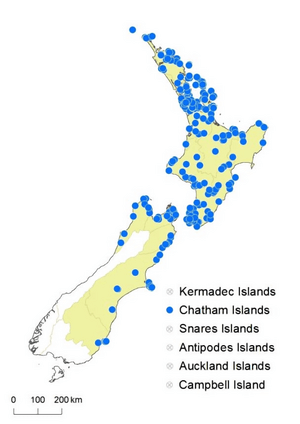 |
|
| Synonyms | |
|
|
The silver fern is a special type of tree fern that grows only in New Zealand. Its scientific names are Alsophila dealbata or Cyathea dealbata. In the Māori language, it is called ponga or punga.
You can easily spot this fern by the shiny, silver-white color on the underside of its older leaves, called fronds. This unique look makes it a well-known symbol of New Zealand, both for people living there and around the world.
Contents
What the Silver Fern Looks Like
This amazing fern can grow very tall, sometimes over 10 meters (about 33 feet)! It usually has a thick top, like a crown. Its mature fronds can be about 4 meters (about 13 feet) long.
The most special thing is the silver-white color on the bottom of these fronds. This bright color was even used by early travelers. They would lay the fronds silver-side up to mark paths for walking at night. The fern's trunk is woody and can be up to 12 meters (about 39 feet) tall. It is covered with old leaf bases that are light brown or white.
Where the Silver Fern Lives
The silver fern arrived in New Zealand a long time ago, about 5 to 1.8 million years ago. You can find it on New Zealand's main islands. However, it is not found in the western and southern parts of the South Island. It also grows on the Chatham Islands to the east.
This fern mostly lives in the shadier parts of dry forests. It also grows in open scrub areas. Sometimes, you can find it at the edges of forests or in more open spots. The silver fern grows best in soil that drains well and has lots of humus (decayed plant matter). Once it's settled, it can handle drier conditions. It likes to be protected from strong winds and frost.
The Silver Fern in New Zealand Culture
The silver fern has been an important symbol for New Zealand for a long time. The New Zealand Army first used it as an official emblem during the Second Boer War. Later, New Zealand soldiers wore the silver fern during both World Wars. You can even see the silver fern carved on the tombstones of fallen New Zealand soldiers in Commonwealth war graves.
During a conflict in 1956, New Zealand peacekeepers wore the silver fern symbol on their uniforms. This helped people tell them apart from British and Australian soldiers. Since then, New Zealand peacekeepers have used both the silver fern and the kiwi bird as symbols.
Some British Army units also wear the silver fern. They do this as a special honor for fighting alongside New Zealand troops. For example, some units that fought with the New Zealand Division in a big battle called the Second Battle of El Alamein wear it.
The silver fern is also used on many products, especially dairy items. It has been a trademark since 1885. Many other groups and companies use it as their logo, like the rail company KiwiRail. There was even a special train called the "Silver Fern."
You can see silver fern fronds on the coat of arms of New Zealand. Some ideas for a new New Zealand flag have also featured the silver fern. The design chosen for a public vote in 2015-2016 included the silver fern. It is also used in politics, for example, as the logo for the New Zealand Labour Party.
The Māori people, who are the first people of New Zealand, discovered the silver fern. An old Māori story says the silver fern once lived in the sea. Māori hunters would use the silver underside of the fern leaves to find their way home at night. When bent, the leaves would catch the moonlight and light up a path through the forest.
The koru symbol is inspired by a new silver fern frond as it unrolls. This symbol is very common in Māori art, like carvings. It is also on the official Māori flag and is the logo for Air New Zealand, the national airline. The koru's round shape shows endless movement, and its spiral shape suggests returning to where things began.
The silver fern is one of the most recognized symbols of New Zealand, along with the kiwi. However, it is not an official national symbol.
-
An Air New Zealand plane with a koru on its tail and a silver fern on its side.
-
An All Blacks jersey from 1905, showing a silver fern.
Use in Sport
The silver fern has been a symbol for New Zealand's national sports teams for a long time. It was first worn by players in 1888-89. The national netball team is even called the "Silver Ferns." Many other national women's sports teams have names based on "Ferns," like the "Black Ferns" (women's rugby) and "Football Ferns" (women's soccer).
Here are some national sports teams that use the silver fern:
- All Blacks (rugby)
- Silver Ferns (netball)
- All Whites (football)
- Tall Blacks (basketball)
- White Ferns (women's cricket)
- Black Caps (men's cricket)
- Black Ferns (women's rugby)
- Black Sticks Men & Black Sticks Women (field hockey)
- Team New Zealand (sailing)
- Iron Blacks (American Football)
The silver fern is also a big part of the official symbols for New Zealand's Olympic teams.
Images for kids
See also
 In Spanish: Helecho plateado para niños
In Spanish: Helecho plateado para niños


